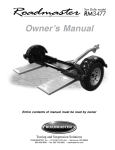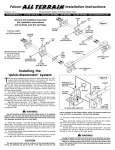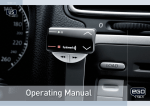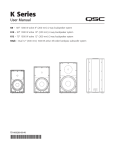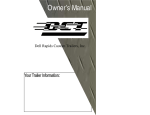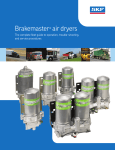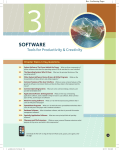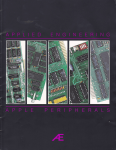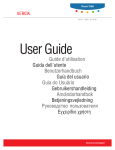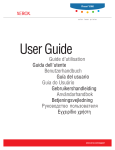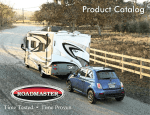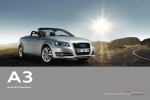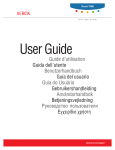Download 2013 Dinghy Tow Guide - Roy Robinson Motorhomes
Transcript
THAN MORE 5 7 LES B A W O T How to Tow Like a Pro 8 Popular Dinghy Braking Systems Essential Accessories For Safe Travel Supplement to MotorHome April 2013 www.motorhome.com Tow & Go I f you enjoy the thrill of exploring the open road in your motorhome, you’ve probably found a few instances where bigger is not always better. That’s where towing a dinghy behind your coach becomes advantageous. Want to know more? The 2013 Guide to Dinghy Towing provides a selection of informative articles and a listing of new vehicles ready-made to enhance your RVing lifestyle. Granted, no manufacturer has yet to engineer a plug-and-play setup directly from the factory, but it’s never been simpler to equip both dinghy and motorhome for road duty. For starters, as highlighted in “Things to Know Before You Tow” (page 6), the hard hookup between motorhome and dinghy has become an easy one-person operation: selfaligning tow bars make cinching up a breeze; with some tow-bar designs, even routing cables and wiring through hollow arms, the connection is more than easy, it’s eye-pleasing. Plus, manufacturers are offering an array of accessories to help keep it that way: An RV underskirt, fitted beneath the equipment, will safeguard the dinghy vehicle and towing hardware from debris. For more ironclad protection, nearly indestructible rock guards are available that quickly attach to the tow bar and shield the dinghy from road debris. Yet another device to aid in safe dinghy transport, supplemental braking systems have likewise evolved. Portable systems can be installed in just minutes, and permanent installations remain unobtrusive. Dinghy brakes may www.motorhome.com not be mandatory in some states but any time you add a few tons of weight to the back of your motorhome, you need a way to slow it down without taxing the brakes on your coach. And make no mistake, contemporary motorhomes can accommodate a lot of dinghy weight. While many new chassis are rated to handle at least 4,000 pounds of dinghy weight, certain luxury coaches today carry gross combined weight ratings (GCWR) of 60,000 pounds or more — with up to 25 percent of that dedicated to towing. The focus of our annual dinghy towing guide is the dinghies themselves. Manufacturers are becoming increasingly sensitive to the needs of the motorhome community, and the “2013 Dinghy Roundup” (beginning on page 12) lists vehicles that have been manufacturercertified for four-wheels-down towing. The list includes many of the newest vehicles — including nine hybrids. For all-terrain fun, there are plenty of 4WD vehicles to choose from. While some vehicles are easy to tow, others require that very specific procedures be followed before and during towing to prevent damage. This year we’ve included expanded information on the manufacturer guidelines required for flat towing, though you’ll still need to check the owner’s manual for more detailed procedures. As motorhomes continue to grow in size and stature, life on the road has never been more comfortable. A dinghy adds to that enjoyment. J 2013 GUIDE TO DINGHY TOWING | 3 24 Contents 6 TOWING ACCESSORIES Prepping your dinghy for safe travel BRAKING 26 DINGHY SYSTEMS THINGS TO KNOW BEFORE YOU TOW Linking up with the proper equipment Popular devices to improve stopping power 12 2013 DINGHY ROUNDUP Our annual guide to manufacturerapproved flat-towable cars, trucks and SUVs Publisher Bob Livingston Editor-in-Chief Eileen Hubbard Art Director Rick Damien Managing Editor Laura Michaels Contributors Rich Cox, Chris Hemer EDITORIAL/BUSINESS OFFICE 3300 Fernbrook Lane N #200 Minneapolis, MN 55447 800-848-6247 Email [email protected] ADVERTISING VP/National Sales Terry Thompson NATIONAL ADVERTISING SALES Southeast Region Tacy Hendershot 1010 SW Lighthouse Drive, Palm City, FL 34990 772-288-0387 Northeast Region Lou Cicirelli 1400 NW 108th Avenue, #266, Plantation, FL 33322 954-297-9234 Seattle, Washington Scott Oakes, John Marciano 1818 Westlake Avenue N, #420, Seattle, WA 98109 Tel 206-283-9545 Fax 206-283-9571 MotorHome is a registered trademark of Affinity Group Inc. Copyright 2013 by Affinity Group Inc. All rights reserved. MotorHome (ISSN 0744-074X) is published monthly by GS Media & Events (a division of Good Sam Enterprises, LLC). Subscription price, U.S. and possessions: 1 year, $19.97. All other countries, add $12 per year. For more information, visit our website:www.motorhome.com. 4 | 2013 GUIDE TO DINGHY TOWING www.motorhome.com Things To Know Before You Tow The Right Equipment Adds Safety, Simplicity and Convenience T raveling with a dinghy vehicle is almost a given with today’s larger motorhomes. Although the trend to bigger coaches has injected camping with more creature comforts than a luxury hotel room, it’s not without its drawbacks. Even rigs with a 60-degree wheel cut will encounter some difficulty negotiating narrow roads in smaller towns during sightseeing tours — and it’s just not fun trying to park a 40-footer at local markets when picking up perishables. A dinghy simplifies such tasks, and eliminates the need to break camp and stow everything each time you need (or want) to venture away from the campground. Additionally, the dinghy can stow gear securely when motorhome storage is filled (within weight restrictions), and there is the security of having a spare set of wheels in the event of an emergency. It’s not without consequences; towing a dinghy will affect the acceleration, fuel economy and braking of any coach, to some degree. However, proper selection of a dinghy vehicle and towing equipment will enable you to safely and conveniently enjoy the benefits of auxiliary transportation. FLAT TOWING The first and most essential step in selecting a dinghy vehicle is to make sure it is approved by its manufacturer for flat towing (see “2013 Dinghy Roundup,” page 12). While you do have other options — many passenger cars or light trucks can safely be used as a dinghy, provided a towing accessory (such as a transmission lube pump) is available for that specific model as an aftermarket add-on, or towing on a dolly or trailer is planned — these vehicles have been certified for four-wheels-down towing without affecting their warranties. However, buyers should always first confirm flat-towability by consulting the vehicle’s owner’s manual before the purchase is finalized. When selecting a dinghy, first find out the maximum towing limit of your motorhome and then determine which vehicles fall within that limit. Towing limits aren’t the only factor to consider, but they help to eliminate many A drop receiver might be needed to keep the tow bar level. 6 | 2013 GUIDE TO DINGHY TOWING Roadmaster’s aluminum Sterling All-Terrain tow bar is rated to handle vehicles up to 6,000 pounds. Non-binding design facilitates hookup. Roadmaster’s Black Hawk 2 All-Terrain has a rating up to 10,000 pounds. Aventa LX from Blue Ox uses a ball-in-socket design, which allows the arms to swivel 360 degrees for quick hookup. The tow bar is rated to tow vehicles up to 10,000 pounds. choices based on weight alone. The weight rating of the motorhome’s hitch receiver is another concern, although most are adequate, and receivers can be upgraded. Keep in mind, however, that an upgraded hitch receiver cannot increase the specified towing limit set by the chassis manufacturer. An economical four-passenger compact car can double as a family’s second car when not traveling, but even a larger SUV or sport truck can be towed, providing its weight is within the towing limit of your chassis. Most flat-towed dinghies track so well that many motorhome drivers don’t even know it’s there. Front-wheel-drive (FWD) vehicles with manual transmissions and most compact 4WD vehicles with manual transfer cases are among the easiest and most economical to tow. Plus, they tend to rank among the lightest vehicles. Some auto manufacturers also produce FWD vehicles equipped with automatic transmissions that are flat-towable. They are popular because towing equipment is readily available, and readying for towing usually involves fewer steps. Demco’s Dominator aluminum tow bar has a rating up to 7,500 pounds. Easy trigger release and self-supporting arms provide convenient connection to baseplate. But some vehicles do require special procedures, such as starting the engine every 200 miles to circulate transmission fluid. Note that this cannot simply be circumvented by overfilling the transmission before towing, because the problem isn’t caused by lack of sufficient fluid but rather by lack of oil circulation. Such practices, although inconvenient, are designed to prevent drivetrain damage and must be incorporated into the towing routine. Another vehicle-specific consideration is that towing some dinghies with the ignition switch in a position that allows the steering column to remain unlocked also leaves power applied to various electrical circuits. Over the course of a full day of towing, this can lead to significant battery drain. While strategies for dealing with this vary by model, most fixes involve temporarily unplugging one or more fuses from the vehicle’s fuse box before towing. A more involved alternative is to connect the offending circuit through an owner-added switch, allowing these circuits to be made tow-ready by the mere flip of a switch. A charge line from the coach can often be a viable alternative. A) Once the tow bar is pinned in the hitch receiver, make sure electric connections and safety cables are secure. B) While driving your dinghy, this type of tow bar remains on the coach, tucked out of harm’s way. A www.motorhome.com B 2013 GUIDE TO DINGHY TOWING | 7 Things to Know Before You Tow A B The Motorhome/Dinghy Link A n essential ingredient in safe dinghy towing involves a solid, properly designed and installed mechanical linkage between the coach and the towed vehicle. Hitch receivers, tow bars and baseplates must all be in good working order, rated for the weight you intend to pull and, when applicable, designed for the specific application. HITCH RECEIVERS Check the rating of the hitch receiver to ensure that it is rated for the heaviest load you intend to pull. If a receiver is already installed on your coach, the weight limits and class should be visible on it. However, the riding height of a motorhome rarely matches up with that of the chosen dinghy, oftentimes necessitating the use of a drop receiver to allow the tow bar to ride level. These As You Go s/BSERVETHESPEEDLIMITFORTOWINGINEACH state or province you traverse. s-AINTAINADEQUATESTOPPINGDISTANCE from the vehicle in front of you. A minimum five-second interval is recommended. s!VOIDTOWINGINSNOWYORICYCONDITIONS s0AYPARTICULARATTENTIONTOTRAFlCMERGING onto the freeway, and be prepared to take evasive action to avoid “daydreamers.” s0LANAHEADMOSTmATTOWEDDINGHIES can’t be backed more than a few feet, so it’s necessary to focus on easy ingress and EGRESS-OSTTOWBARMANUFACTURERSWILL 8 | 2013 GUIDE TO DINGHY TOWING are available in 2- to 10-inch variations. Receivers should be bolted (not welded) in place, using at least Grade 5 bolts and lock washers, locking nuts and thread-locking sealer. TOW BARS Tow bars are available in two basic styles: A-frame or self-aligning. A-frame tow bars (offered as “solid” or “folding”), while the most economical, are designed to fit a limited number of baseplates (the mounting brackets affixed to the dinghy) or specific applications; however, the folding design will fit a wider range than the solid design. These types of tow bars are strong, but heavy, and require storage space when not in use. Hitching is easier with a helper to guide alignment. Self-aligning tow bars are available in two styles: dinghy-mounted and coach-mounted. not warrant damage caused by backing. Dollies tend to jackknife quickly. It’s better to disconnect the dinghy and drive to a safe place to reconnect. s!VOIDHAVINGTOMAKETIGHTTURNSTHEYPUT a lot of pressure on tow bars. s4OWINGINDEEPSANDORGRAVELMAYCAUSE the dinghy’s front wheels to turn to one side. If this happens, you must manually re-center them before continuing. s7ALKAROUNDTHECOACHANDDINGHYTO inspect all connections, check tire pressure (or use a monitoring system like THEN6ISION40-3FROM(OPKINSANDLOOK for signs of trouble every time you stop. www.motorhome.com C D A) Baseplate installation doesn’t require welding or specialized tools, but can be involved. If you have any reservations, have a professional do it. B) To hook up using a telescoping tow bar, the dinghy vehicle only needs to be near the center and mid-length of the bar. C) Connecting tow-bar arms to the baseplate requires the use of pins and clips. Then secure the safety cables and plug in the electrical umbilical cord. D) Once the pins are in, the motorhome is driven ahead slowly (or the dinghy is backed up) to lock the arms in position. Coach-mounted units are the most desirable, as there is less chance of damage when not in use — and hitching is a one-person operation. Highly adaptable, self-aligning tow bars fit a broad range of vehicles by attaching to modelspecific baseplates: Class III (5,000-lb) or Class IV (10,000-lb) models are available. Contact tow-bar manufacturers to find out if baseplates are offered for the dinghy you plan to tow. BASEPLATES Baseplates are perhaps the most critical variable in this link. While tow bars and, obviously, hitch receivers are intended for mass fitment, various brands, models and years of dinghy vehicles require different baseplates and installation procedures, so proper selection and installation are essential. Installing a baseplate typically entails very specific procedures. On some vehicles the bumper covering (fascia) must be temporarily removed. Some minor drilling may be required and the bumper covering and/or grille may also require some trimming. On some vehicles, the baseplate installation process can be even more intricate. For example, the air dam may need to be trimmed or the factory-installed belly pan may require either trimming or permanent removal. Such requirements are described in the manufacturer’s fitment charts — hopefully eliminating any unpleasant surprises at installation time. www.motorhome.com Before You Tow s -AKESUREYOUREQUIPMENTISRATEDFOR the dinghy’s weight and that you are not exceeding your motorhome’s gross combination weight rating (GCWR). s #ONlRMHITCHHEIGHTISCORRECT s #ONlRMALLHITCHBOLTSANDTOWBAR and baseplate fasteners are securely tightened. s #ONlRMALLHITCHANDWIRINGCONNECTIONS are engaged and secure; all safety chains or cables are attached; and all locking pins are properly installed. s #ONNECTBRAKESYSTEMANDBREAKAWAY device. s #HECKMOTORHOMEANDDINGHYFOR proper function of taillights, brakelights and turn signals. s #HECKTIREPRESSUREOFALLTIRESONCOACH and dinghy — including spare tires. s -AKESURETHEDINGHYISSETUPFORTOW ing: steering unlocked; emergency brake off; gear selector in the position specified by manufacturer; ignition in proper position; lube-pump switch, driveshaft coupler, 4WD transfer case and hubs (if applicable) in proper position. Today’s baseplates do a good job of blending into the exterior lines of the dinghy vehicle. Remember that all 50 states require properly rated safety chains or cables to keep the dinghy from separating from the coach if the tow bar or ball fails. Safety chains or cables should be connected securely to the dinghy and crossed under the tow bar, then secured to the hitch receiver. They should be long enough to allow full turning without binding, but not drag when slack. 2013 GUIDE TO DINGHY TOWING | 9 Things to Know Before You Tow Modern baseplates are secured to the frame of the dinghy vehicle. While some installations are a little more complicated, the end result usually is a clean appearance. Other Towing Equipment S hould you choose (or already own) a vehicle that is not flat-towable as produced, there are retrofit kits for many models. One retrofitter, Remco Manufacturing (www.remcotowing.com) estimates 80 percent of passenger vehicles can be modified to serve as dinghies with its line of retrofit products. For rear-wheel-drive (RWD) and some 4WD applications, couplers enable the driveshaft to be easily disconnected from the transmission or differential by a cable or lever mounted near the driver’s seat. These kits run about $750 and can be installed in about three hours. A transmission-lube pump can be mounted and plumbed into some automatic transmissions to keep fluid circulating while the vehicle is in tow. Other FWD vehicles can be adapted using a Remco axle-lock disengagement device. Check Baseplate kits are designed for specific models, and come complete with all mounting hardware. with your dealer to make sure a specific modification does not affect the dinghy’s warranty. Tow dollies also offer an alternative to flat towing, although they take up space in camp. Remember that the dolly weight must be figured in with the total weight of the dinghy. Trailers track better than dollies, but they take up even more precious space in camp. Also, the weight of the trailer drastically cuts into the total weight that can be pulled behind a motorhome, thereby making this method a distant third choice. There are a number of other accessories for dinghy towing. Some, like dinghy braking devices, should be considered mandatory, while others (such as rock guards and RV underskirts) protect against road debris. These components are addressed in “Towing Accessories” (page 24), along with dinghy wiring and lighting. J Lube pumps allow towing of some automatic transmission-equipped vehicles not manufacturerapproved for flat towing. 2013 Guide to Dinghy Towing Sponsors Produced by the editors of MotorHome for the publication’s April issue, the 2013 Guide to Dinghy Towing was developed with assistance from the following companies: Blue Ox Products 800-228-9289, www.blueox.com Demco 888-689-1810, www.towdemco.com Forest River 574-533-5934, www.forestriverinc.com 10 | 2013 GUIDE TO DINGHY TOWING Hopkins Manufacturing 800-835-0129, www.hopkinsmfg.com Roadmaster Inc. 800-669-9690, www.roadmasterinc.com RVibrake 800-815-2159, www.rvibrake.com www.motorhome.com Dinghy Towing 2013 Fuel-Efficient Hybrids and Small SUVs Top This Year’s List T he practice of towing another vehicle four-wheels-down behind a motorhome is still the most practical way for motorhome owners to get around once they’ve reached their destination. In the early years, only a handful of manufacturers recognized the practice, but by the year 2000, it seemed that the movement was finally gaining steam. Although some models have withdrawn for 2013 (see sidebar, “Where are they now?”), the demand for more fuelefficient cars has expanded the field of dinghy offerings. Examples include vehicles by Dodge, Ford, Hyundai and Subaru, which will suit a variety of needs and lifestyles. You’ve probably noticed that there are other vehicles out there being dinghy towed that aren’t on our list, and you may have wondered why. To put it simply, the vehicles in our guide must be approved by the manufacturer for dinghy towing in order to qualify. That means the manufacturer is familiar with the practice of dinghy towing, and has confirmed that its vehicle can be towed in this manner without causing damage to the drivetrain or otherwise voiding the warranty. Second, the vehicle must be towable without requiring significant mechanical modification (such as disconnecting the driveshaft, for example). Lastly, the vehicle must be towable at a speed of at least 55 MPH for no fewer than 200 miles before some sort of prescribed startup procedure is required to circulate fluid through the transmission and/or transfer case. You’ll note that some vehicles will appear and disappear from the list every year, and that’s largely because of changes to the vehicle and/or its drivetrain. In other instances, a manufacturer may not have had time to test a new vehicle’s dinghy towing worthiness in time for last year’s guide, and has since determined that the vehicle is towable. Keep in mind that we’ve made every effort to check, and double check with each manufacturer to make sure that our listings are correct and current. However, much of the information we receive is preliminary when the guide is compiled, and can change by the time this issue goes HYUNDAI VELOSTER 12 | 2013 GUIDE TO DINGHY TOWING www.motorhome.com by Chris Hemer to press. Therefore, we cannot stress enough that you check with the dealer to be certain that the vehicle you are considering is dinghy towable. Ask to see a copy of the owner’s manual; somewhere in the index, there should be a notation for “recreational,” “four-down,” or “flat” towing. If the owner’s manual states that the vehicle is not towable, consider something else, or be prepared to modify the vehicle and probably void any stated warrantees. With all that being said, let’s take a look at some of the new flat-towable offerings for 2013. DODGE DART With old model names like Charger and Challenger making a comeback at Chrysler Corp., it should come as no surprise that it has added another to the list: the Dodge Dart. All-new for 2013, the Dart is the first child of the Chrysler/ Fiat marriage, based on Fiat Group architecture. Built in the U.S., the Dart is available in five trim levels, 12 exterior colors, 14 interior color and trim combinations, six wheel options, three engine options and three transmissions, although only the six-speed manual version is deemed towable. It also was engineered with more than 60 safety and security features, including 10 air bags, four-wheel DODGE DART anti-lock disc brakes, stability control, hill start assist and more. Inside, the Dart features a class-exclusive “floating island bezel,” which houses an available 7-inch thin film transistor (TFT) LED customizable gauge cluster display or the available Uconnect Touch 8.4-inch touchscreen Media Center — the largest touchscreen in its class, according to Chrysler. FORD C-MAX HYBRID AND C-MAX ENERGI PLUG-IN HYBRID The Ford C-MAX Hybrid and C-MAX Energi Plug-In Hybrid are two new environmentally www.motorhome.com FORD FUSION ENERGI friendly choices on this year’s list. Designed specifically to compete with Toyota’s popular Prius v, the C-MAX Hybrid combines a 1.4 kW lithium-ion battery and a 2.0-L four-cylinder Atkinson cycle engine to achieve 47 MPG city/ highway mileage. Standard features include seven air bags, AdvanceTrac traction control with Roll Stability Control and Sync with MyFord Touch, an infotainment system that offers multiple ways for customers to manage their phone, navigation, climate and entertainment functions. The C-MAX Energi is mechanically similar, but with its larger 7.6 kW lithium-ion battery, it gets an EPA-estimated 108 city/92 highway MPGE (miles per gallon equivalent). The battery can be charged at home with a 120-volt AC outlet in roughly seven hours, or just 2.5 hours with an available 240-volt AC charging station. It offers the same standard features as the C-MAX Hybrid, plus an interesting remote control feature. Using Ford’s MyFordMobile smartphone app, owners can receive instant vehicle status information, perform key functions, monitor the vehicle’s state of charge and current range, get alerts when the vehicle requires charging or has finished charging, program charge settings and download vehicle data for analysis — all remotely. For those interested in a more familiar form, Ford is also offering its Fusion in plug-in hybrid form with the introduction of the Fusion Energi. Using the same drivetrain as the C-MAX Energi, Ford projects that the Fusion Energi will be the most fuel-efficient midsize car in America. HYUNDAI VELOSTER TURBO Last year, the unusual Hyundai Veloster made the list, and this year it’s followed by the even sportier Veloster Turbo. Powered by a 201-HP, 1.6-L direct-injected turbocharged four-cylinder engine, Hyundai claims the 2,800-pound 2013 GUIDE TO DINGHY TOWING | 13 2013 Dinghy Roundup Where Are They Now? Each year, we see models come, and models go. This year, a few real favorites are no longer approved for towing by their manufacturers, including the Ford Escape and Suzuki Grand Vitara. As we’re sure you’re aware, the Ford Escape was completely redesigned for 2013, and that update includes a non-towable six-speed automatic transmission as its sole offering. And American Suzuki Motor Corporation has unfortunately filed for bankruptcy, so obviously we can’t list any 2013 models — though you can probably make a smoking deal on a 2012 while they last. The Dodge Caliber has been discontinued, the Hyundai Sonata is no longer approved for dinghy towing, Kia has withdrawn the models it said were towable last year, and Toyota’s Scion brand has politely excused all of its models from dinghy-tow duty. Veloster turbo has a better power-to-weight ratio than rivals like the Mini Cooper S and VW GTI. Aside from the more powerful engine, the Veloster turbo also gets sport-tuned suspension, 18-inch alloy wheels with chrome inserts, a unique front fascia with fog lights, ground effects package and more. Inside, Veloster turbo features leather seating with the word “turbo” stitched into the seatbacks, and Hyundai Blue Link, which offers voice-to-text messaging, point of interest (POI) web search download, turn-by-turn navigation and other features. Only manual transmission models are towable. JEEP PATRIOT 4WD Adventurous drivers will be glad to know that the Jeep Patriot 4WD with manual transmission is now approved for towing. Billed as the best-priced compact sport utility vehicle in America, the Patriot includes standard features such as electronic stability control, electronic roll mitigation, hill-start assist, anti-lock disc brakes, fog lamps, tilt steering column, cruise control and a 60/40 split folding rear seat. Options include a Uconnect media center with JEEP PATRIOT iPod interface, SiriusXM Radio, navigation with SiriusXM Travel Link, power sunroof and a premium audio system. SUBARU XV CROSSTREK SUBARU XV CROSSTREK Subaru is famous for high-riding, all-wheeldrive models like the Forester and Outback. For 2013, it offers a new addition to the lineup with the XV Crosstrek. Boasting the best fuel efficiency of any AWD crossover utility in America, according to Subaru, the XV Crosstrek offers 8.7 inches of ground clearance, 17-inch alloy wheels, larger front brake rotors and a 15.9-gallon fuel tank. It’s available in Premium and Limited models, with standard features like heated front seats, mirrors and windshield de-icer, tilt-telescoping steering wheel, power door locks and mirrors, Bluetooth connectivity and more. The upscale Limited model adds luxury features like leather, auto climate control and auto on/off headlights. Only manual transmission models are towable. J This guide addresses only 2013 vehicles. Guides for earlier model years are available online at www.motorhome.com 14 | 2013 GUIDE TO DINGHY TOWING www.motorhome.com 2013 Dinghy Roundup MAKE/ MODEL BASE CURB WEIGHT SPEED/ DISTANCE LIMITS TOWABLE TOWABLE WITH MANUAL WITH AUTO TRANS. TRANS. BUICK Enclave FWD/AWD 4,724/4,922 65 MPH/None N/A Yes Regal 3,600/3,671 60 MPH/None Yes No CADILLAC SRX FWD/AWD 4,277/4,442 65 MPH/None N/A Yes MILEAGE CITY/ HWY. APPROX. RETAIL PRICE SPECIAL PROCEDURES (SEE OWNER’S MANUAL FOR DETAILED INSTRUCTIONS) 17/24-16/22 $39,270-$46,450 Run engine at beginning of day and at each fuel stop for 5 minutes. Remove 15-amp ECM and OnStar fuses, and 50-amp BATT1 fuse. 19/31-25/36 $29,900-$35,865 Run engine at beginning of day and at each fuel stop for 5 minutes. 17/24-16/23 $38,050-$45,920 Run engine at beginning of day and at each fuel stop for 5 minutes. Remove shift lever boot. Press and hold manual release button. CHEVROLET Avalanche 4WD 5,803 None N/A Yes 15/21 $38,355-$40,025 Requires optional Active, 2-Speed Transfer Case. Cruze 3,102 65 MPH/None Yes No 28/42 Equinox 3,777 65 MPH/None N/A Yes 22/32 Equinox AWD 3,922 65 MPH/None N/A Yes 20/29 Silverado 1500 4WD Silverado 1500 4WD Hybrid Sonic 4,892 5,882 None None N/A N/A Yes Yes 15/21 20/23 $16,720-$23,110 Remove fuses 22, 23, 24 and 25 from fuse block. $24,015-$31,775 Run engine at beginning of day and at each fuel stop for 5 minutes. Remove fuse 32. $26,765-$33,525 Run engine at beginning of day and at each fuel stop for 5 minutes. Remove fuse 32. $24,585-$42,930 $45,255-$52,035 2,690 65 MPH/None Yes Yes* 26/35 Spark Suburban 1500 4WD Tahoe 4WD 2,269 5,824 55 MPH/None None Yes N/A No Yes 32/38 15/21 5,567 None N/A Yes 15/21 Tahoe 4WD Hybrid Traverse 5,891 4,713 None 65 MPH/None N/A N/A Yes Yes 20/23 17/24 Traverse AWD 4,956 65 MPH/None N/A Yes 16/23 18/27 25/36 13/20 DODGE Challenger 4,082 65 MPH/ None Dart Durango R/T AWD 5.7-L V-8 3,186 5,330 None None Yes Yes N/A No No Yes Ram 1500 4WD 4,893 None N/A Yes Ram 2500 4WD 5,997 None Yes Yes 16 | 2013 GUIDE TO DINGHY TOWING $13,735-$18,495 Run engine at beginning of day and at each fuel stop for 5 minutes. Remove fuse DLIS. *1.8 model only $12,995-$16,720 $47,630-$60,680 Requires optional Active, 2-Speed Transfer Case. $44,885-$58,145 Requires optional Active, 2-Speed Transfer Case. $56,845 $31,370-$41,285 Run engine at beginning of day and at each fuel stop for 5 minutes. Remove 15-amp ECM and OnStar fuses, and 50-amp BATT1 fuse. $33,370-$43,285 Run engine at beginning of day and at each fuel stop for 5 minutes. Remove 15-amp ECM and OnStar fuses, and 50-amp BATT1 fuse. $25,795-$44,775 Transmission in NEUTRAL. $15,995-$19,295 Transmission in NEUTRAL. $37,095-$42,195 Requires 2-Speed Transfer Case. Transmission in PARK, transfer case set to NEUTRAL. 16/24 $23,595-$46,270 Transmission in PARK, transfer case set to NEUTRAL. Not Rated $31,405-$48,875 For automatic transmissions, shift into PARK; manual transwww.motorhome.com MAKE/ MODEL BASE CURB WEIGHT SPEED/ DISTANCE LIMITS TOWABLE TOWABLE WITH MANUAL WITH AUTO TRANS. TRANS. MILEAGE CITY/ HWY. APPROX. RETAIL PRICE SPECIAL PROCEDURES (SEE OWNER’S MANUAL FOR DETAILED INSTRUCTIONS) missions place in gear, not NEUTRAL. Manual and electronic shift transfer cases must be in NEUTRAL: See “Shifting Into Neutral,” in owner’s manual. Not Rated $39,520-$56,570 For automatic transmissions, shift into PARK; manual transmissions place in gear, not NEUTRAL. Manual and electronic shift transfer cases must be in NEUTRAL: See “Shifting Into Neutral,” in owner’s manual. Ram 3500 4WD 7,152 None No Yes FIAT 500 2,358 None Yes No 31/40 $15,500-$17,500 Transmission in NEUTRAL. 500 Cabrio 2,408 None Yes No 31/40 $19,500-$23,500 Transmission in NEUTRAL. FORD C-MAX Energi 3,899 65 MPH/None N/A Yes 108/92 $33,745 C-MAX Hybrid 3,640 65 MPH/None N/A Yes 47/47 $24,995-$27,995 Edge 3.5-L/3.7-L 4,056 65 MPH/None N/A Yes 19/27 $25,850-$35,435 4,534-4,697 65 MPH/None N/A Yes 17/24 $28,460-$40,045 16/21 $28,310-$52,455 Explorer 3.5-L F-150 4WD 4,925 None N/A Yes F-250/F-350/F-450 Super Duty 4WD 6,985 None N/A Yes Fiesta 2,578 70 MPH/None Yes Yes www.motorhome.com Not Rated $29,455-$65,140 29/37 $13,745-$17,600 Run engine at beginning of day for 5 minutes (shift into DRIVE, then REVERSE and NEUTRAL) and every 6 hours thereafter. Run engine at beginning of day for 5 minutes (shift into DRIVE, then REVERSE and NEUTRAL) and every 6 hours thereafter. Run engine at beginning of day for 5 minutes (shift into DRIVE, then REVERSE and NEUTRAL) and every 6 hours thereafter. Run engine at beginning of day for 5 minutes (shift into DRIVE, then REVERSE and NEUTRAL) and every 6 hours thereafter. Turn ignition to ON, press and hold brake pedal, move 4WD switch to 2H, shift transmission to NEUTRAL. Rotate 4WD switch from 2H to 4L and back five times. Turn ignition as far as it will go toward OFF. Leave key in ignition while towing. Only 4WD models with manual-shift transfer case (not Electronic Shift-Onthe-Fly) are towable. Shift manual transfer case into NEUTRAL, set hub locks to FREE. For automatic transmission, but no push-button start: release parking brake; turn ignition to II; press brake pedal, shift into NEUTRAL; turn ignition key to OFF position, release brake pedal; disconnect negative cable from battery. After towing, start engine within 15 minutes of reconnecting battery cable. For automatic transmission and push-button start: release parking brake; activate ignition, press START/STOP button, press brake pedal, then shift to NEUTRAL and release 2013 GUIDE TO DINGHY TOWING | 17 2013 Dinghy Roundup MAKE/ MODEL BASE CURB WEIGHT SPEED/ DISTANCE LIMITS TOWABLE TOWABLE WITH MANUAL WITH AUTO TRANS. TRANS. MILEAGE CITY/ HWY. APPROX. RETAIL PRICE SPECIAL PROCEDURES (SEE OWNER’S MANUAL FOR DETAILED INSTRUCTIONS) brake pedal; deactivate ignition, press START/STOP button, disconnect negative cable from the battery. After towing, start engine within 15 minutes of reconnecting battery cable. Flex 4,471-4,643 65 MPH/None N/A Yes 18/25 Focus 2,907 70 MPH/None Yes Yes 26/36 Fusion Fusion Energi 3,333 3,913 70 MPH/None 70 MPH/None Yes N/A No Yes 25/37 N/A Fusion Hybrid 3,615 70 MPH/None N/A Yes 47/47 3,969-4,196 65 MPH/None N/A Yes 19/29 GMC Acadia FWD/AWD 4,656/4,850 65 MPH/None N/A Yes Sierra 1500 4WD 4,877 None N/A Yes Sierra 1500 4WD Hybrid Terrain FWD/AWD 5,791 None N/A Yes 3,853 65 MPH/None N/A Yes Taurus 3.5-L 18 | 2013 GUIDE TO DINGHY TOWING $28,210-$36,555 Run engine at beginning of day for 5 minutes (shift into DRIVE, then REVERSE and NEUTRAL) and every 6 hours thereafter. $15,495-$24,495 For automatic transmission, but no push-button start: release parking brake; turn ignition to II; press brake pedal, shift into NEUTRAL; turn ignition key to OFF position, release brake pedal; disconnect negative cable from battery. After towing, start engine within 15 minutes of reconnecting battery cable. For automatic transmission and push-button start: release parking brake; activate ignition by pressing START/STOP button; press brake pedal, then shift to NEUTRAL and release brake pedal; deactivate ignition by pressing START/STOP button; disconnect negative cable from the battery. After towing, start engine within 15 minutes of reconnecting battery cable. $21,700 Transmission in NEUTRAL. N/A Start engine and allow it to run for 5 minutes at the beginning of each day and every 6 hours thereafter. $27,200 Start engine and allow it to run for 5 minutes at the beginning of each day and every 6 hours thereafter. Select “Neutral Tow” mode — refer to owner’s manual. $27,395-$36,995 Run engine at beginning of day for 5 minutes (shift into DRIVE, then REVERSE and NEUTRAL) and every 6 hours thereafter. 17/24-16/23 $35,070-$46,965 Run engine at beginning of day and at each fuel stop for 5 minutes. Remove 15-amp ECM and OnStar fuses, and 50-amp BATT1 fuse. 14/18 $27,330-$43,085 Transfer case must be set to NEUTRAL. 20/23 $44,705-$51,485 Transfer case must be set to NEUTRAL. 22/32-20/29 $26,660-$32,995 Run engine at beginning of each day and at each fuel stop for 5 minutes. Remove fuse 32. After towing, let engine idle for more than 3 minutes before driving vehicle. www.motorhome.com 2013 Dinghy Roundup MAKE/ MODEL BASE CURB WEIGHT SPEED/ DISTANCE LIMITS Yukon 4WD 5,567 None N/A Yes 15/21 Yukon 4WD Hybrid 5,917 None N/A Yes 20/23 Yukon XL 1500 4WD 5,824 None N/A Yes 15/21 HONDA CR-V 3,305 65 MPH/None N/A Yes 23/31 CR-V 4WD 3,426 65 MPH/None N/A Yes 22/30 2,496-2,577 65 MPH/None Yes Yes* 28/35 Fit HYUNDAI Accent Elantra (all) Tucson GL FWD Genesis Coupe Veloster Veloster Turbo INFINITI G37S Sport 6MT Convertible G37S Sport 6MT Coupe G37S Sport 6MT Sedan JEEP Compass Compass 4WD Grand Cherokee Limited and Overland TOWABLE TOWABLE WITH MANUAL WITH AUTO TRANS. TRANS. MILEAGE CITY/ HWY. APPROX. RETAIL PRICE $45,440-$49,770 Only 4WD models equipped with a 2-speed automatic transfer case are towable. $56,625 Transfer case must be set to NEUTRAL. $47,690-$51,870 Only 4WD models equipped with a two-speed automatic transfer case are towable. $22,795-$29,045 Start engine, press brake pedal, move shifter through all positions, shift into DRIVE and hold for 5 seconds, then to NEUTRAL and let engine run for 3 minutes. Repeat at least every 8 hours thereafter. When towing for long periods, remove 7.5-A radio fuse. $24,045-$30,295 Start engine, press brake pedal, move shifter through all positions, shift into DRIVE and hold for 5 seconds, then to NEUTRAL and let engine run for 3 minutes. Repeat at least every 8 hours thereafter. When towing for long periods, remove 7.5-A radio fuse. $15,425-$19,790 *On automatic transmission models, run engine at the beginning of each day, press brake pedal and move shifter through all positions, shift into DRIVE and hold for 5 seconds, then to NEUTRAL and let engine run for 3 minutes. Repeat at least every 8 hours thereafter. When towing for long periods, remove 30A radio fuse. 2,396 2,661 3,319 3,362 2,584 2,800 None None None None None None Yes Yes Yes Yes Yes Yes No No No No No No 28/37 28/38 22/29 21/30 27/37 24/35 $14,545-$16,095 $16,815-$18,395 $19,245 $22,250 $17,450 $21,950 4,149 70 MPH/500 miles Yes No 16/24 $52,000 3,708 70 MPH/500 miles Yes No 17/25 $50,500 3,709 70 MPH/500 miles Yes No 17/25 $41,500 3,101 3,216 4,850 None None None Yes Yes N/A No No Yes 23/30 23/28 16/23 20 | 2013 GUIDE TO DINGHY TOWING SPECIAL PROCEDURES (SEE OWNER’S MANUAL FOR DETAILED INSTRUCTIONS) Idle engine in NEUTRAL for 2 minutes every 500 miles. Idle engine in NEUTRAL for 2 minutes every 500 miles. Idle engine in NEUTRAL for 2 minutes every 500 miles. $19,210-$24,495 $21,395-$26,395 $26,995-$42,995 Only 4WD vehicles with Quadra-Trac II (V-6 models) and Quadra-Drive II systems www.motorhome.com MAKE/ MODEL BASE CURB WEIGHT SPEED/ DISTANCE LIMITS TOWABLE TOWABLE WITH MANUAL WITH AUTO TRANS. TRANS. MILEAGE CITY/ HWY. APPROX. RETAIL PRICE SPECIAL PROCEDURES (SEE OWNER’S MANUAL FOR DETAILED INSTRUCTIONS) (V-8 models) are towable. Shift transfer case to NEUTRAL, transmission must be in PARK. See “Shifting Into Neutral,” in owner’s manual. Patriot 2WD Patriot 4WD Wrangler 4WD 3,111 3,263 3,760 None None None Yes Yes Yes No No Yes 23/30 23/28 17/21 Wrangler Unlimited 4WD 4,075 None Yes Yes 16/20 4,204-4,436 65 MPH/None N/A Yes MKT 3.7-L FWD/AWD 4,702-4,942 65 MPH/None N/A Yes MKX 3.7-L FWD/AWD 4,236-4,413 65 MPH/None N/A Yes LINCOLN MKS FWD/AWD www.motorhome.com $15,995-$23,795 $17,995-$25,695 $22,045-$29,995 With engine off, press brake pedal, shift automatic transmission into NEUTRAL or press clutch pedal on manual transmission, shift transfer case lever into NEUTRAL, start engine. Shift transmission into REVERSE, release brake pedal (and clutch pedal on manual transmissions) for 5 seconds, shift automatic transmission in DRIVE or manual transmission in first gear, release brake pedal (and clutch pedal on manual transmissions) for 5 seconds. Turn engine off, apply parking brake, shift transmission into PARK or place manual transmission in gear (not in NEUTRAL), hook up vehicle to tow bar, release parking brake. $25,695-$34,095 With engine off, press brake pedal, shift automatic transmission into NEUTRAL or press clutch pedal on manual transmission, shift transfer case lever into NEUTRAL, start engine. Shift transmission into REVERSE, release brake pedal (and clutch pedal on manual transmissions) for 5 seconds, shift automatic transmission in DRIVE or manual transmission in first gear, release brake pedal (and clutch pedal on manual transmissions) for 5 seconds. Turn engine off, apply parking brake, shift transmission into PARK or place manual transmission in gear (not in NEUTRAL), hook up vehicle to tow bar, release parking brake. 17/25-18/27 $42,810-$49,800 Run engine at beginning of day for 5 minutes (shift into DRIVE, then REVERSE and NEUTRAL) and every 6 hours thereafter. 17/25-16/23 $45,285-$47,280 Run engine at beginning of day for 5 minutes (shift into DRIVE,then REVERSE and NEUTRAL) and every 6 hours thereafter. 19/26-17/23 $39,545-$41,395 Run engine at beginning of day for 5 minutes (shift into DRIVE, then REVERSE and NEUTRAL) and every 6 hours thereafter. 2013 GUIDE TO DINGHY TOWING | 21 2013 Dinghy Roundup MAKE/ MODEL MKZ 3.7-L FWD/AWD BASE CURB WEIGHT SPEED/ DISTANCE LIMITS 3,719-3,874 65 MPH/None TOWABLE TOWABLE WITH MANUAL WITH AUTO TRANS. TRANS. N/A Yes MILEAGE CITY/ HWY. APPROX. RETAIL PRICE SPECIAL PROCEDURES (SEE OWNER’S MANUAL FOR DETAILED INSTRUCTIONS) 22/33-22/31 $35,925-$39,045 Run engine at beginning of day for 5 minutes and every 6 hours thereafter. See “Neutral Tow,” in owner’s manual. MKZ Hybrid 3,828 70 MPH/None N/A Yes 45/45 $35,925 Run engine for 1 minute at beginning of day (shift into DRIVE, then REVERSE and NEUTRAL). See “Neutral Tow,” in owner’s manual. NISSAN 370Z Coupe 3,245 70 MPH/500 miles Yes No 18/26 $33,910 370Z Roadster 3,459 70 MPH/500 miles Yes No 18/25 $44,960 Cube 2,768 60 MPH/500 miles Yes No 25/30 $17,550 Frontier King/ Crew Cab 2WD I-4 Frontier King/ Crew Cab 2WD V-6 Frontier King/ Crew Cab 4WD V-6 3,690 None/500 miles Yes No 19/23 $20,085 4,152 None/500 miles Yes No 16/20 $23,965 4,294 None/500 miles Yes No 15/19 $27,915 Juke FWD SL, SV 2,959 70 MPH/500 miles Yes No 27/32 $21,481 Sentra 2,822 None/500 miles Yes No 27/36 $15,990 Versa 2,345 None/500 miles Yes No 27/36 $10,990 Xterra Manual 4WD S 4,143 None/500 miles Yes No 16/20 $29,295 Idle engine in NEUTRAL for 2 minutes every 500 miles. Idle engine in NEUTRAL for 2 minutes every 500 miles. Idle engine in NEUTRAL for 2 minutes every 500 miles. Models with Continuously Variable Transmission (CVT) are not flat towable. Idle engine in NEUTRAL for 2 minutes every 500 miles. Idle engine in NEUTRAL for 2 minutes every 500 miles. Place transfer case in 2H range. Idle engine in NEUTRAL 2 minutes every 500 miles. Idle engine in NEUTRAL for 2 minutes every 500 miles. Idle engine in NEUTRAL for 2 minutes every 500 miles. Idle engine in NEUTRAL for 2 minutes every 500 miles. On 4WD models, place transfer case in 2H range. Idle engine in NEUTRAL for 2 minutes every 500 miles. SUBARU Forester 2.5X Impreza 2.0i Impreza WRX Impreza WRX STI 3,250 2,911 3,208 3,384 None None None None Yes Yes Yes Yes No No N/A N/A 21/27 25/34 19/25 17/23 Legacy 2.5i Outback 2.5i XV Crosstrek 3,315 3,423 3,087 None None None Yes Yes Yes No No No 21/28 19/27 23/30 TOYOTA Corolla 2,734 None Yes No 27/34 Matrix 1.8-L 2,844 None Yes No 26/32 Matrix 2.4-L 2,976 None Yes No 21/28 Yaris 2,295 None Yes No 30/37 22 | 2013 GUIDE TO DINGHY TOWING $21,295-$24,295 $17,895-$20,795 $25,795-$29,295 $34,295-$37,645 STI requires driver’s control center differential (DCCD) be set in MANUAL mode and DCCD control dial be set to the farthest rearward position. $20,295 $23,495- $29,095 $21,995-$22,995 $16,230-$18,230 After towing, idle engine for at least 3 minutes before driving. $19,275 After towing, idle engine for at least 3 minutes before driving. $20,265 After towing, idle engine for at least 3 minutes before driving. $14,370-$16,480 After towing, idle engine for at least 3 minutes before driving. www.motorhome.com Towing Accessories Plug receptacles added to the dinghy and coach allow easy hookup of an electrical connector for taillights, turn signals and the supplemental braking system. T he research has been done, the financing arranged, the papers signed … and that new dinghy vehicle is now sitting in your driveway. You’ve shopped carefully to pick a model that’s certified by its manufacturer for flat towing, you’ve checked the vehicle’s weight to confirm that it’s within the motorhome’s safe towing capabilities and you’ve ordered it with any requisite factory options to make it towable with all wheels rolling. Now what? As any seasoned motorhome owner will tell you, there are a lot of steps involved in getting a new vehicle to the point where it can be towed safely. Unfortunately, no automaker offers a plug-and-play solution that makes its products ready for safe dinghy towing right from the factory. Thus, it’s up to you (and perhaps a knowledgeable towing equipment dealer) to get the job done right. DINGHY WIRING One of the most important aspects of dinghy prep involves connecting the wiring between the two vehicles. Tail, brake and turn signals on the back of the dinghy are required in all 50 states and all Canadian provinces, so this isn’t a step that you can overlook. (Neither side clearance nor backup lights are required, and are rarely used.) The most common source of dinghy wiring confusion centers on differences in the way the turn-signal lights are wired on various cars and motorhomes. Some models are wired to supply turn-signal power to the same bulbs that are used for the brakelights (commonly referred to as a 4-wire system), while others use separate amber bulbs for the rear turn signals (a 5-wire system). Note that 4- and 5-wire systems are used on both motorhomes and cars, so any one of four solutions may be needed for any particular application. Adapters are readily available to electronically match the wiring systems of the dinghy and motorhome. The traditional method of wiring a dinghy vehicle involves the use of steering diodes, which function as one-way gates to the flow of electricity, allowing power from either the motorhome or vehicle to be supplied to the rear bulbs. Because no electricity can flow backward through a diode, it also prevents power from the motorhome from being inadvertently introduced to any other circuits in the dinghy vehicle. Many late-model vehicles are equipped with on-board diagnostics that continuously check for proper operation of turn-signal and brakelight bulbs. Unfortunately, the introduction of aftermarket steering diodes into the vehicle’s wiring can “fool” this diagnostic function, typically causing it to give false warnings about burned-out bulbs. For this reason, it’s common to modify each of the vehicle’s tail-lamp assemblies to accept a separate bulb. This bulb is then connected Left: One-way diodes, such as this one from Roadmaster, prevent electrical feedback when using the dinghy’s lighting circuit. Right: As an alternative, you can install an extra pair of lamps on your dinghy independent of its electrical system. 24 | 2013 GUIDE TO DINGHY TOWING Accessory kits such as this one from Demco include everything needed for a safe hookup, including wiring kits, pins, locks, receptacles — and a cover to keep the tow bar protected from the elements. directly to the motorhome, eliminating any connections to the vehicle’s existing wiring harness. This modification usually involves drilling a large hole in the tail-lamp reflector. Fortunately, special snap-in sockets are available that make this job somewhat easier. Since the new socket takes up considerable space behind the lamp assembly, care must be taken in selecting a location for the new hole that avoids socket interference with any other objects behind it. Note that most states allow the turn signals to be either red or amber in color, but only permit the brakelights to be red. Thus, on automobiles equipped with amber turn signals, the new socket is typically installed behind the red brake-lamp lens. Hopkins nVision Tire Pressure Monitoring System keeps an eye on motorhome and dinghy tire air pressure. The wireless system can be easily transferred between vehicles and used in the dinghy without the motorhome. In situations where modifications to the dinghy’s original wiring either aren’t desirable or practical, a set of removable towing lights often provides a workable solution. Most of these products are affixed with magnets, although some models can be equipped with suction cups or hook-and-loop fasteners (ideal for use on plastic or fiberglass surfaces). A cable is then snaked across the vehicle to the connector at the motorhome hitch receiver. In some cases, the cable is semipermanently routed inside or underneath the vehicle, allowing the lights to be quickly removed and stowed inside the trunk. Several companies offer wireless, removable towing lights, thereby eliminating the need for this cable altogether. Although many motorhomes come with a factory-installed 4- or 5-pin connector, there are situations where a different connector is necessary. Some unapproved dinghies equipped with an automatic transmission must also be equipped with an electric lube pump, www.motorhome.com which requires a connector pin for 12-volt DC power (and ideally, a separate connector pin for ground, in order to avoid drawing excessive current through the existing one). Also, some auxiliary braking systems require connections to the motorhome, further increasing the connector-pin count. Ideally, the industry-standard connection scheme should be observed when installing this new connector, so that it can also be used when towing boats, ATVs, horse trailers, etc. Unfortunately, since no industrywide standard exists for wire color codes used in automobiles, another hurdle in dinghy wiring involves identifying the proper wires for the stop, turn and tail lamps (as well as a suitable ground connection). If you’ve had the foresight to purchase a service manual for your particular vehicle, this can sometimes be accomplished by visual inspection of the wire harness. More often than not, it involves connecting a test light to each suspected wire in order to match it with the corresponding bulb. Note that on 4-wire systems, the same wire may be “hot” when either the brake or one of the turn signals is operated. When splicing diodes or other connections into the vehicle’s wiring harness, it is important to use top-quality connectors or splices. In order to prevent any chance of corrosion, all connections should be waterproof. Heatshrink tubing works very well for this purpose, as does self-vulcanizing plastic tape. J Above: Adding large rubber flaps at the rear of a motorhome, such as these from Blue Ox, will minimize towed-vehicle damage from debris, dirt and grime kicked up by coach tires. Below: The KarGard shield, from Blue Ox, attaches to the tow bar and adds yet another level of dinghy protection, guarding against potential damage from road debris. 2013 GUIDE TO DINGHY TOWING | 25 by Chris Hemer Dinghy Braking Systems More complete and better than ever I f you’re like a lot of motorhome owners, you’d probably like to put a bumper sticker on the back of your towed vehicle that reads, “It’s a motorhome thing. You wouldn’t understand.” Because only motorhome owners realize the benefits of dinghy towing — the freedom to travel anywhere without having to break camp. But when you’re shopping for the necessary equipment to tow a vehicle behind your motorhome, don’t stop at the tow bar and baseplate. A supplemental dinghy brake system — designed to apply the brakes in the towed vehicle when the coach’s brakes are applied — should be considered a necessity as well. Anytime you tow something and apply the brakes, that towed load is going to push on the coach, extending its stopping distance. For that reason, some chassis manufacturers specify that towed loads in excess of 1,500 pounds should have independent brakes and safety breakaway systems. The fact that dinghy brakes are not always required by law in all states is inconsequential. Many state and local governments are either unfamiliar with the practice of dinghy towing, or simply have not considered it, but that doesn’t mean towing without supplemental 26 | 2013 GUIDE TO DINGHY TOWING dinghy braking is a safe practice. Fortunately, there are a number of dinghy braking systems on the market. Some are completely portable (easily transferable from one vehicle to another) some are semi-portable (can be used in another vehicle with some exceptions) and some are permanent (require modification to coach and/or dinghy and therefore can’t be transferred from one vehicle to the next). This year a couple of new systems were introduced to the market. The BrakeBuddy Stealth is the latest from Hopkins and it can be installed in an inconspicuous place virtually anywhere in the dinghy vehicle. From Danko, the RViBrake2 is the first unit to have a tire air pressure monitor as part of the package. Refinements from Roadmaster and Blue Ox continue to make braking devices more effective and user friendly. The popular systems on the following pages — those from Blue Ox, BrakeBuddy, Roadmaster and RViBrake — generally have a significant edge in ease of installation. Use of a dinghy-braking device saves wear and tear on your coach’s brakes, while providing the confidence of state and provincial compliance and safe travels. www.motorhome.com Dinghy Braking Systems HOPKINS MANUFACTURING What’s Included: Diagnostic wireless remote and emergency breakaway system. BrakeBuddy DIGITAL CLASSIC portable supplemental braking system MSRP: $1,149 How it’s Installed: First, install the emergency breakaway system. Next, set the BrakeBuddy on the dinghy’s driver’s side floor in front of the driver’s side seat and attach the clevis to the brake pedal. Adjust the driver’s seat forward to touch the adjustable handle of the BrakeBuddy. Plug in the 12-volt DC power and emergency breakaway cords. Then, verify the program settings customized to your dinghy’s weight or braking sensitivity and plug in the wireless remote inside the motorhome. Total installation time is less than 30 minutes; after the initial installation, the setup time for towing is less than five minutes. How it Works: By way of an electronic decelerometer, the BrakeBuddy senses the inertia created during braking. The sensed inertia activates an internal air cylinder that puts a specified amount of pressure on the towed vehicle’s brake pedal. An air compressor and tank supply the air pressure. The coach operator is notified of the towed vehicle’s braking via the BrakeBuddy Alert System, which has a light that indicates that safe braking has occurred. BrakeBuddy VANTAGE SELECT portable supplemental braking system MSRP: $1,499 How it’s Installed: Same installation procedure as the Digital Classic BrakeBuddy How it Works: Operates the same as the Classic BrakeBuddy, but with the addition of a fully automatic one-touch startup button. Choose between Full and Proportional braking technology at the touch of a button. Features and Benefits: sh/NTHEmYv"RAKING!DJUSTABILITY6ANTAGE Select lets the driver adjust braking sensitivity on the fly from the coach to react to changing ROADCONDITIONS5TILIZESRADIOFREQUENCY technology and is AA-battery powered. s&ULLY!UTOMATIC3TARTUPFEATURE0USHTHEAUTO STARTBUTTONAND6ANTAGE3ELECTPREPARESITSELF for use. This allows the driver the opportunity to ensure the dinghy brakelights are operational. What’s Included: Diagnostic wireless remote and emergency breakaway system. BrakeBuddy STEALTH Features and Benefits: s"ILLIONSOFMILESOFEXPERIENCE s4HREEYEARDAYMONEYBACKGUARANTEE s-EETSOREXCEEDSALLSTATEANDPROVINCIAL towing laws. s5TILIZESADVANCEDTERRAINSENSINGTECHNOLOGY and provides the right braking force needed. s4HEUNITSCOMPACTDESIGNlTSWITHINALL towed vehicles and is lightweight at only 12 pounds. Because it is portable, it can easily be transferred from vehicle to vehicle. 28 | 2013 GUIDE TO DINGHY TOWING supplemental braking system MSRP: $999-$1099 How it’s Installed: STEALTH main unit www.motorhome.com Dinghy Braking Systems mounts anywhere in the towed vehicle you desire. Patent-pending all-in-one adapter mounts at the front of the vehicle, and the dual controller mounts inside the motorhome where it is easily viewed and within reach. How it Works: Senses the inertia of the braking event, and communicates the exact amount of pressure to apply the towed vehicle’s brake pedal. After braking, the vacuum pump restores vacuum to the towed vehicle. Features and Benefits: s#OMPACTUNITMOUNTSANYWHEREINDINGHY s%ASYINSTALLATION s$UALCONTROLLEROFFERShONTHEmYvSENSITIVITYAND GAINADJUSTMENTS#ANBESWITCHEDBETWEEN dinghy towing and conventional trailer towing. s$UALBRAKINGMODEALLOWSTOWINGADINGHY vehicle or trailer at the push of a button. s%ASYTOUSE0LUGINADAPTERWHILEATTACHING the tow bar and it’s ready to go (also connects lights, braking system and charge line). What’s Included: Main unit, All-In-One adaptER$UAL#ONTROLLERANDMOUNTINGHARDWARE Contact: (OPKINS-ANUFACTURING#ORP 800-470-2287; www.brakebuddy.com BLUE OX Patriot portable supplemental braking system MSRP: $999.99 How it’s Installed: Place on the driver’s side mOORBOARDADJUSTPUSHPADFEETATTACHSPRING loaded brake claw to brake pedal, plug unit in, push the button and the unit self-calibrates. How it Works: When the coach’s brakes are applied, the Patriot applies progressive and proportional braking force using an electric cylinder and actuator. 30 | 2013 GUIDE TO DINGHY TOWING Features and Benefits: s3ELFCONTAINEDUNITSITSONTHEmOORINFRONT of the driver’s seat. Installed within a few minutes after the initial installation. s7ORKSWITHALLCOACHESANDTOWEDVEHICLES s&EATURESINTERNALVOLTBATTERYTOEXTEND towed vehicle battery life. s!DJUSTABLEPUSHPADANDFEET s7EIGHSONLYPOUNDS What’s Included:%VERYTHINGNEEDEDFORBASIC installation, including hardware and brake bracket assembly. Contact: Blue Ox WWWBLUEOXCOM ROADMASTER BrakeMaster permanently mounted brake system MSRP: $1,304.68 (for coaches with hydraulic brakes), $883.85 (for motorhomes with air over hydraulic or air brakes) How it’s Installed: The BrakeMaster is connected directly to the motorhome’s air or hydraulic brake line. The initial installation (in the coach and the towed vehicle) takes from four to six hours, depending on the motorhome’s brake system and the specific towed vehicle. Once the initial installation is complete, BrakeMaster connects and disconnects from the towed vehicle in just a minute or two, without any tools, adjustments or settings. Attach the brake pedal clamp to the towed vehicle’s BRAKEPEDALSECURETOTHEmOORORSEATADAPTER and quick-connect the air hose. How it Works: Because it connects directly to what powers the motorhome’s brakes, BrakeMaster is a truly proportional, truly synchronized braking system — brake line pressure in the coach controls the brakes in the towed vehicle. Whenever the motorhome’s brakes are applied, BrakeMaster automatically applies www.motorhome.com Dinghy Braking Systems the same pressure to the dinghy vehicle. Features and Benefits: s0ROPORTIONALBRAKINGMEANSTHETOWED VEHICLESBRAKESRESPONDTOTHECOACHSBRAKES at the same time and at the same intensity. s%MERGENCYBREAKAWAYSYSTEMISINCLUDED s7ORKSINVIRTUALLYANYVEHICLEWITHPOWER BRAKES s-ONITORLIGHTINTHEMOTORHOMESDASH ILLUMINATESWHENTHETOWEDVEHICLESBRAKES are applied. s-EETS53AND#ANADIANBRAKINGREQUIRE ments. What’s Included: "RAKE-ASTERSYSTEMMONI TORLIGHTBREAKAWAYSYSTEMWIRINGANDELECTRI CALCOMPONENTSEASYTOREADINSTALLATIONAND operating instructions. Even Brake PORTABLEBRAKINGSYSTEM MSRP: $1,555.60 How it’s Installed: The initial installation of ELECTRICALCOMPONENTSINTHETOWEDVEHICLE TAKESLESSTHANANHOUR/NCETHEINITIALINSTAL LATIONISCOMPLETE%VEN"RAKECONNECTSAND DISCONNECTSFROMTHETOWEDVEHICLEINJUSTA MINUTEORTWO0OSITION%VEN"RAKEBETWEEN THEDRIVERSSEATANDTHEBRAKEPEDALANDAD JUSTTHEPEDALCLAMPOVERTHEBRAKEPEDAL MOVETHEDRIVERSSEATFORWARDAGAINST%VEN "RAKEPLUGINTHEWIRINGHARNESSCORDANDTHE POWERCORDANDPRESSTHETESTBUTTON How it Works:%VEN"RAKEAUTOMATICALLY INCREASESORDECREASESBRAKINGPRESSUREINDI RECTPROPORTIONTOTHEMOTORHOME7HENTHE COACHBRAKESAREAPPLIEDANELECTRONICMICRO PROCESSORINSIDE%VEN"RAKESIGNALSAMAGNETIC valve to release a proportional amount of air PRESSUREACTIVATINGTHEBRAKECYLINDERWHICH 32 | 2013 GUIDE TO DINGHY TOWING APPLIESBRAKINGFORCEONTHETOWEDVEHICLES BRAKEPEDAL4HEAMOUNTOFBRAKEPRESSUREAP PLIEDISDETERMINEDBYTHEAMOUNTOFBRAKING pressure applied in the motorhome. Features and Benefits: s0ROPORTIONALBRAKING s4HREETIEREDMOTORHOMEMONITOR,%$ LIGHT,#$TEXTMESSAGEAUDIOTONEPROVIDES COMPLETECONTINUOUSBRAKINGINFORMATIONAT AGLANCE2EPORTSANYBRAKINGACTIVITYORA CHANGEINSYSTEMSTATUSTOAWIRELESSMONI tor in the motorhome. s#ONTINUOUSMONITORINGALLOWSANYCHANGES INSYSTEMSTATUSTOBETRANSMITTEDTOCOACH monitor. s0OWER3AVELOWBATTERYPROTECTIONWARNSOF ALOWBATTERYINTHETOWEDVEHICLEWITH,%$ AND,#$ALERTSATTHEMOTORHOMEMONITOR s!UTOMATICBRAKEPROTECTIONALERTSTHEDRIVER AFTERANEXTENDEDPERIODOFCONTINUOUSBRAK INGTHENRELEASESBRAKINGPRESSURETOAVOID EXCESSIVEWEARONDINGHYBRAKES s/NBOARDMEMORYREMEMBERSTHESETTINGS EVENWHENUNPLUGGEDANDWILLAUTOMATI CALLYADJUSTITSELF s)NCLUDESABRAKERELAYTOALLOWTHEDINGHYS TURNSIGNALSANDBRAKELIGHTSTOWORKSIMULTA NEOUSLYWITHTHEDINGHYTOMOTORHOMEELEC trical connection. What’s Included:%VEN"RAKEUNITMOTOR HOMEMONITORTOWEDVEHICLETRANSMITTER BREAKAWAYSYSTEMBRAKELIGHTRELAYEASYTO read installation and operating instructions. InvisiBrake FULLYAUTOMATICPROGRESSIVESUPPLEMENTAL BRAKINGSYSTEM MSRP: $999.99 How it’s Installed:)NMOSTAPPLICATIONSTHE )NVISI"RAKECONTROLLERISINSTALLEDBENEATHTHE FRONTSEATOFTHETOWEDVEHICLE!NAIRCYLINDER ISINSTALLEDCLOSETOTHECONTROLLERABRACKET www.motorhome.com Dinghy Braking Systems and cable pulley are installed on the brake pedal arm. The entire system is designed to stay in the vehicle. How it Works: InvisiBrake uses the towed vehicle’s electrical harness — the same electrical signal that activates the towed vehicle’s brakelights also activates InvisiBrake. Features and Benefits: s.OTHINGTOPUTINORTAKEOUTTOTOWORDRIVE s(IDDENFROMVIEWNOUNSIGHTLYEQUIPMENT in the car. InvisiBrake is so small (8¾-by-8¾by-2¾ inches) it can usually be mounted under the driver’s seat. s3IMPLEOPERATION7ORKSINTUITIVELY.OFUSS no hassle. s#HARGESTHEBATTERY)NVISI"RAKECONNECTS directly to the towed vehicle’s battery and constantly charges the battery during towing. s)NVISI"RAKEENGAGESTHEPOWERBRAKINGSYS TEMPROVIDINGTHESAMEPOWERBRAKES whether towing or driving. s7ORKSINVIRTUALLYANYTOWEDVEHICLEWITHVACUUM POWEREDBRAKESINCLUDINGHYBRIDSANDTHOSEWITH FULLTIMEACTIVEPOWERBRAKINGSYSTEMS s)NCLUDESANEMERGENCYBREAKAWAYSYSTEM and two-stage monitor alarm. What’s Included: 4HE)NVISI"RAKECONTROLLER CABLEAIRCYLINDERBRAKEPEDALBRACKETALL electrical wiring and a breakaway system. Contact: 2OADMASTER)NC 800-669-9690; www.roadmasterinc.com DANKO MANUFACTURING RVibrake2 auxiliary braking system MSRP: $1,350 grate tire pressure monitoring and towed vehicle braking all in one. RVibrake Tire Pressure 3ENSORSSIMPLYTHREADONTOTHETOWEDVEHI cle’s valve stems and are activated when the 26IBRAKE7IRELESS-ONITORISENABLED How it’s Installed: 4HE"REAKAWAY3YSTEMIS the only thing that has to be permanently inSTALLEDINTHEDINGHYVEHICLE)NSTALLATIONOFTHE breakaway takes approximately 25-45 minUTES/NCETHEBREAKAWAYISINSTALLEDPLACE 26IBRAKEONTHEmOORBOARDOFTHETOWEDVE hicle and push the AUTO-START button. This will NOTONLYDEPLETETHEVACUUMINTHEBRAKESBUT ITWILLALSOAUTOPOSITIONITSELF4HEREISNONEED TOADJUSTTHESEATBECAUSE26IBRAKEPUSHES UPAGAINSTTHERISEINTHEmOORPAN3ETTINGUP the RVibrake2 takes less than 60 seconds. How it Works: RVibrake2 is an inertiaactivated system. It applies the brakes in the towed vehicle only when the coach driver applies the brakes in the motorhome. RViBRAKESCUTTINGEDGESOFTWAREADJUSTSFOR TERRAINWHETHERTHEMOTORHOMEISGOING uphill or downhill. The RVibrake2 housing pushes against the floor pan (the rise in the floor where the DRIVERSSEATISMOUNTEDINSTEADOFTHESOFT seat when activating. This allows RVibrake2 to be truly proportional. Features and Benefits: s26IBRAKEISCOMPATIBLEWITH26IBRAKE 4IRE0RESSURE3ENSORS s)NSTALLATIONONLYTAKESSECONDS s/NETOUCHAUTOPOSITIONING s4RUEPROPORTIONALBRAKING s4HREEYEARWARRANTY s-OTORHOMEDRIVERCANMONITORPERFORMANCE ANDADJUSTSETTINGSONTHEmYFROMTHECOACH WITHTHE7IRELESS-ONITOR s&ITSINALLVEHICLES s7EIGHSPOUNDS s!VAILABLEACCESSORIESINCLUDEASOFTSHELLCASE FORSTORAGEANDAVOLT$#$IRECTTO "ATTERY+IT What’s Included: 7IRELESS-ONITORAND breakaway system. RVibrake2 is the first braking system to inte- 34 | 2013 GUIDE TO DINGHY TOWING Contact: $ANKO-ANUFACTURING WWWRVIBRAKECOMJ www.motorhome.com





































